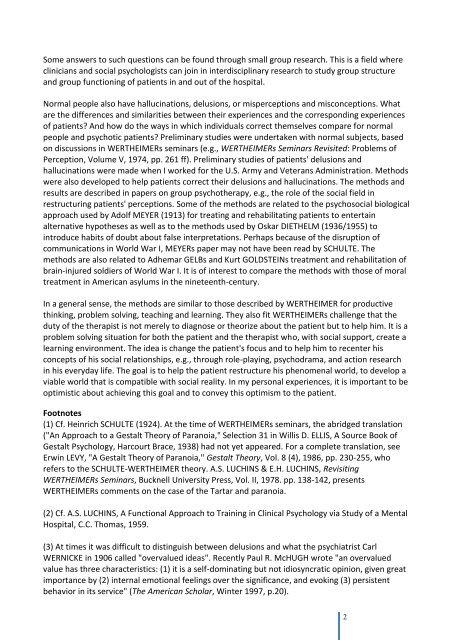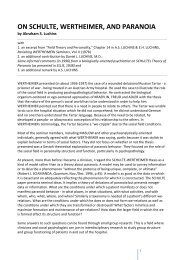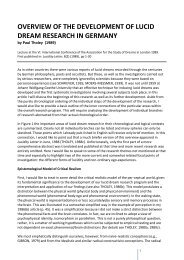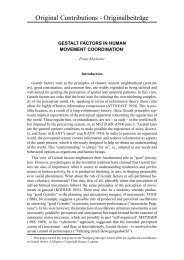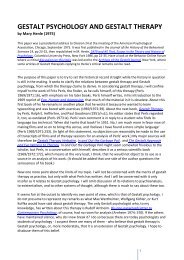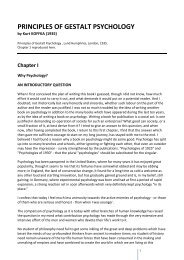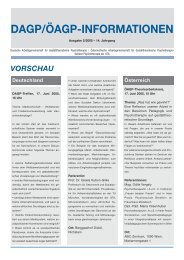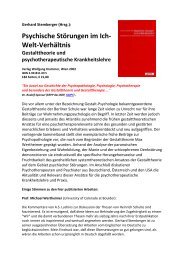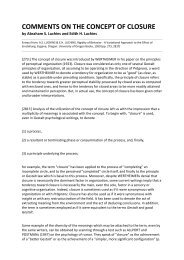pdf-Download - Society for Gestalt Theory and its Applications (GTA)
pdf-Download - Society for Gestalt Theory and its Applications (GTA)
pdf-Download - Society for Gestalt Theory and its Applications (GTA)
Create successful ePaper yourself
Turn your PDF publications into a flip-book with our unique Google optimized e-Paper software.
Some answers to such questions can be found through small group research. This is a field where<br />
clinicians <strong>and</strong> social psychologists can join in interdisciplinary research to study group structure<br />
<strong>and</strong> group functioning of patients in <strong>and</strong> out of the hospital.<br />
Normal people also have hallucinations, delusions, or misperceptions <strong>and</strong> misconceptions. What<br />
are the differences <strong>and</strong> similarities between their experiences <strong>and</strong> the corresponding experiences<br />
of patients? And how do the ways in which individuals correct themselves compare <strong>for</strong> normal<br />
people <strong>and</strong> psychotic patients? Preliminary studies were undertaken with normal subjects, based<br />
on discussions in WERTHEIMERs seminars (e.g., WERTHEIMERs Seminars Revisited: Problems of<br />
Perception, Volume V, 1974, pp. 261 ff). Preliminary studies of patients' delusions <strong>and</strong><br />
hallucinations were made when I worked <strong>for</strong> the U.S. Army <strong>and</strong> Veterans Administration. Methods<br />
were also developed to help patients correct their delusions <strong>and</strong> hallucinations. The methods <strong>and</strong><br />
results are described in papers on group psychotherapy, e.g., the role of the social field in<br />
restructuring patients' perceptions. Some of the methods are related to the psychosocial biological<br />
approach used by Adolf MEYER (1913) <strong>for</strong> treating <strong>and</strong> rehabilitating patients to entertain<br />
alternative hypotheses as well as to the methods used by Oskar DIETHELM (1936/1955) to<br />
introduce hab<strong>its</strong> of doubt about false interpretations. Perhaps because of the disruption of<br />
communications in World War I, MEYERs paper may not have been read by SCHULTE. The<br />
methods are also related to Adhemar GELBs <strong>and</strong> Kurt GOLDSTEINs treatment <strong>and</strong> rehabilitation of<br />
brain-injured soldiers of World War I. It is of interest to compare the methods with those of moral<br />
treatment in American asylums in the nineteenth-century.<br />
In a general sense, the methods are similar to those described by WERTHEIMER <strong>for</strong> productive<br />
thinking, problem solving, teaching <strong>and</strong> learning. They also fit WERTHEIMERs challenge that the<br />
duty of the therapist is not merely to diagnose or theorize about the patient but to help him. It is a<br />
problem solving situation <strong>for</strong> both the patient <strong>and</strong> the therapist who, with social support, create a<br />
learning environment. The idea is change the patient's focus <strong>and</strong> to help him to recenter his<br />
concepts of his social relationships, e.g., through role-playing, psychodrama, <strong>and</strong> action research<br />
in his everyday life. The goal is to help the patient restructure his phenomenal world, to develop a<br />
viable world that is compatible with social reality. In my personal experiences, it is important to be<br />
optimistic about achieving this goal <strong>and</strong> to convey this optimism to the patient.<br />
Footnotes<br />
(1) Cf. Heinrich SCHULTE (1924). At the time of WERTHEIMERs seminars, the abridged translation<br />
("An Approach to a <strong>Gestalt</strong> <strong>Theory</strong> of Paranoia," Selection 31 in Willis D. ELLIS, A Source Book of<br />
<strong>Gestalt</strong> Psychology, Harcourt Brace, 1938) had not yet appeared. For a complete translation, see<br />
Erwin LEVY, "A <strong>Gestalt</strong> <strong>Theory</strong> of Paranoia," <strong>Gestalt</strong> <strong>Theory</strong>, Vol. 8 (4), 1986, pp. 230-255, who<br />
refers to the SCHULTE-WERTHEIMER theory. A.S. LUCHINS & E.H. LUCHINS, Revisiting<br />
WERTHEIMERs Seminars, Bucknell University Press, Vol. II, 1978. pp. 138-142, presents<br />
WERTHEIMERs comments on the case of the Tartar <strong>and</strong> paranoia.<br />
(2) Cf. A.S. LUCHINS, A Functional Approach to Training in Clinical Psychology via Study of a Mental<br />
Hospital, C.C. Thomas, 1959.<br />
(3) At times it was difficult to distinguish between delusions <strong>and</strong> what the psychiatrist Carl<br />
WERNICKE in 1906 called "overvalued ideas". Recently Paul R. McHUGH wrote "an overvalued<br />
value has three characteristics: (1) it is a self-dominating but not idiosyncratic opinion, given great<br />
importance by (2) internal emotional feelings over the significance, <strong>and</strong> evoking (3) persistent<br />
behavior in <strong>its</strong> service" (The American Scholar, Winter 1997, p.20).<br />
2


